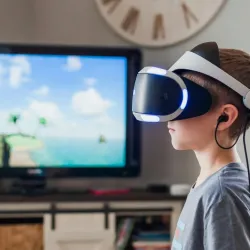Events, Industry Knowledge
Changing the Game: AI’s Profound Influence on Digital Commerce

The way we purchase goods is evolving. According to a recent HBR survey1, 80% of U.S. customers are still changing their shopping habits, visiting less stores and buying more online. In particular, the past year-and-a-half has seen a great consumer shift2, with online shopping significantly increasing across multiple categories.
But these only reflect very broad, surface-level changes in consumer purchasing. In the world of artificial intelligence and machine learning, specific, game-changing developments are taking place—innovations set to change digital commerce, forever.
Trailblazing Digital Commerce through a Ubiquitous Platform
New York-based artificial intelligence company TheTake is shaping the way we buy through a medium we all know and love: TV. They’re essentially transforming television into an interactive product discovery engine, allowing viewers to discover and engage with goods in their favorite shows and events. Ken Aizawa, the firm’s Head of AI, explains:
“Some of the richest experiences that we can have is watching a movie or TV show. And not only are consumers spending all of that time online… they're doing that increasingly through what's one of the fastest growing device categories and households: the connected TV… So I've situated our products in this continuity of commerce and advertising, meeting consumers where they are, whether that's in the physical highways of the past, or the information highways of the present… We're working tirelessly, every day to meet consumers where they are now, and that's consuming digital video.”
Articulating Digital Experiences in the Information Age
What enables TheTake to articulate these digital experiences in the information age is a concept you might not have heard of: Software 2.0. As Ken points out, “The key difference between software 2.0 and software 1.0 is that 2.0 is all about expressing content and experiences for the information age, using data rather than code. And so what you'll see is that now, and increasingly in the future, both physical and digital world experiences are shaped by systems which adapt to data, rather than being constant and hard-coded, allowing those systems to react to, for example, your engagement with them, or to broader cultural trends.”
Software 2.0 is critical to powering the entire experience, end-to-end. It allows the company to coalesce data from very disparate sources—thousands of hours of TV shows and movies every year, a database of 250 million products from hundreds of e-commerce retailers, viewership data from devices, and user engagement data. All these inform which TV shows they tag, the products they take and identify within them, and how they rank them in the interface to any given viewer on any given device.
Artificial Intelligence and Machine Learning: The Tools of the Trade
To call the amount of raw data being created “overwhelming” is an understatement. Our human brains have a limited bandwidth of time and attention to consume, which is why high-tech companies use tools like artificial intelligence (AI) and machine learning (ML) to overcome this obstacle.
At TheTake, for example, AI and ML are being used for processes like video processing, extracting contextual information, video detection, identifying and tracking characters, and product identification. “But now, the most important learning is not just establishing your data, your data infrastructure, and then your layer of AI and ML to compress that data into meaningful experiences—the most important learning is closing that loop to create a healthy and sustainable mechanism for enabling feedback to flow back into your AI and ML algorithms and into your data,” Ken adds.
The Importance of Building Feedback Loops from the Start
Having feedback flow into your AI and ML models allows you to “really spin flywheels that will continuously and almost autonomously refine” the user and consumer experience. By enabling customers to give feedback—through share and like buttons, for instance—and by tracking and acting on it, you’re able to really regulate and improve user experience.
Ken goes on to explain that not implementing such feedback systems can create harmful and negative experiences for people as some social media platforms probably still prioritize disinformation and misinformation, in some cases.
“...if you need more evidence of why closing the loop is just growing in importance, you just have to look at the emergence of all of these different platforms that offer closed-ended data labeling, and annotation systems, and tools and teams to enable that—whether that's identifying objects in video to train autonomous vehicles, or that's moderating content on social media platforms, identifying misinformation and disinformation. All of that should tell you that the work of the future to build the future information world is not engineering work, but data work. And it's essentially work that frontloads that data compression, that overwhelming amount of data… frontloading that work onto internal teams, so that external users don't have to do that work themselves, or worse, have to experience the negative effects of things like disinformation, and misinformation...”
TaskUs provides the best quality human intelligence to power such examples of AI and ML data work. From training self-driving cars to ad delivery platforms, our global experts on human-driven tech processes and solutions provide clients with a deep understanding of industry best practices. This enables them to scale training data programs efficiently, effectively—and excellently.
To learn more about TheTake and how AI and data are shaping the way we buy, watch the latest installment of the Forward Series: AI and the Future of Digital Commerce on-demand via this link.
References
We exist to empower people to deliver Ridiculously Good innovation to the world’s best companies.
Services








